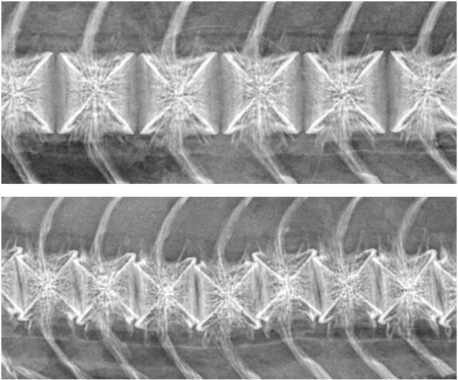Cross-stitch vertebrae is a type of deformity in farmed salmon that is initiated by oil-based vaccines used to prevent pancreas disease (PD) in salmon. The vaccines cause a transient defect in the vertebral growth zone. How environment impact further growth of the vertebrae will decide whether a deformity develops or not.
The COVID epidemic has been a reminder that vaccines have side effects, and that we must weigh the side effects against the protection they provide. Good vaccines have had a major impact on the salmon industry, and have helped control serious diseases and kept the use of antibiotics out of salmon production.
In the autumn and winter of 2016-17, there were reports of a new type of spinal deformity in slaughtered fish, and fish farmers suspected a relation to the use of a new vaccine against PD. The deformities were particularly severe, with a high number of abnormal vertebrae, reduced weight gain and reduced fillet quality. X-rays clearly showed that these deformities differed from other types of spinal defects, and they were called ‘cross-stitch vertebrae’ in order to distinguish them from other, more common deformities.
Analysis of production data from producers who were affected by the problem clearly showed that the vaccine was a risk factor. Scientists at Nofima also confirmed what the fish farmers already observed; that autumn smolts were much more susceptible than spring smolts. However, there was considerable variation between otherwise comparable groups, so it was obvious that something more than just the vaccine had influenced the reaction in the vertebrae.

Ring-shaped vertebral weakness
The scientists gained access to sample material from slaughterhouses. It clearly showed that this was a specific problem that was similar from fish to fish and between different fish groups and fish farms.
“The key to understanding what went wrong was found through histology. In vertebrae that had the typical appearance on X-rays, we found a ring-shaped weakness running symmetrically around the centre of the vertebrae, sometimes also with a fracture of the vertebral endplate”, says senior scientist Grete Bæverfjord, who has led this research.
At Nofima’s research station at Sunndalsøra, Bæverfjord and her colleagues set up a long-term trial in order to follow the development of this pathology, from vaccination and through to slaughter. They had four different vaccine groups: Unvaccinated fish, fish vaccinated with a standard vaccine without a PD component, and two groups that were vaccinated with the two oil-based PD vaccines that were on the market at the start of the trial.
Growth zone defects after vaccination
The trial fish developed normally, showing good growth and low mortality rates. They were then slaughtered at an average weight of 3.8 kilograms. No X-ray pathology was seen until the last sampling. A clear, albeit low, prevalence of cross-stitch vertebrae was found in the two PD-vaccinated groups, and not in the other two.
In tissue studies (histology), the scientists found vertebral growth zone changes in the period after vaccination. There were increased deposits of the protein fibrin and irregularities in the bone-producing cells in the growth zone. As the fish grew, normal bonecontinued to form, while the weakness that were inducedin the period after vaccination remained in the location where it had formed. After being slaughtered, the scientists found the typical cross-stitch changes using X-rays and histology. X-ray control measurements showed that the ring-shaped weakness that had formed was consistently located where the vertebral growth zone was at the time of vaccination.
Temperature during the post-smolt stage
A subgroup of fish was withheld at seawater transfer and placed in seawater tanks at 6 and 12 degrees, respectively. The scientists found several indications, both in growth patterns and on histology, that the reaction to the vaccine was stronger at the higher temperature. This may indicate that temperature and growth patterns after transferring to sea are factors that have an impact on whether the pathology develops or not, but this is something that needs to be investigated further.
“We don’t have any answers as to what it is about these vaccines that triggers the cross-stitch reaction. Is it the PD component, or is it something else? We have reason to believe that bone cell trials are an approach that can be used to get closer to an answer”, says Bæverfjord.
The project was financed by the Norwegian Seafood Research Fund (FHF), and was a collaboration between Nofima, NMBU Faculty of Veterinary Medicine, INAQ AS, Pharmaq AS and Pharmaq Analytiq AS.










